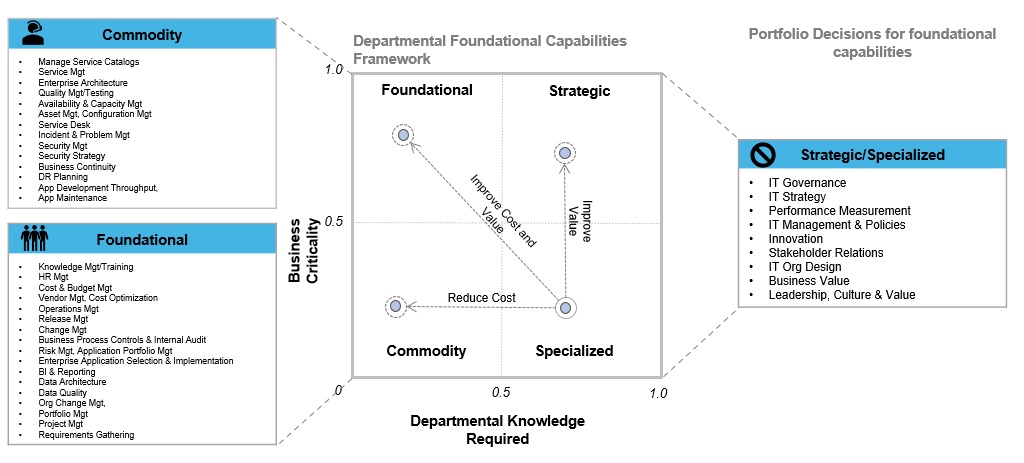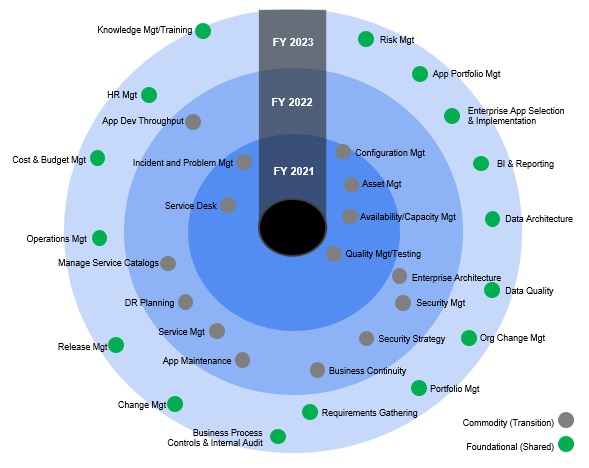Which activities do you do today that you should probably delegate? Similarly, which activities does your department own that probably should be delegated?
Hi, I’m Peter Nichol, Data Science CIO.
Today we’re going to talk about managed service providers or MSPs.
Why make the shift to MSPs?
The concept behind a managed service provider is to shift ownership of daily activities to allow your team to focus on more important strategic priorities.
The concept sounds pretty simple. However, telling the team that 90% of what they did yesterday is going to be outsourced is tough. However, if we go back to basics, the principle of leveraging MSPs makes sense.
Consider for a minute what activities in your own life you delegate. Maybe you outsource lawn care to the neighbor kids or hire a cleaning company to keep the vacation property looking amazing. In both cases, you’ve decided that your time is better spent somewhere else—you can add greater value by doing a different type of activity. This is the same business case your organization is making. Your team’s time is better spent on building out core organizational capabilities, not focusing on non-essential organizational capabilities.
The case for MSPs in our business
Similarly, when we perform our organizational duties, we often take ownership of pieces that fall through the cracks over time. We tell ourselves it’s necessary to address the immediate need—for example, a frustrated stakeholder or client. Then, in the light of being a good corporate citizen and helping our peers, we shoulder this additional responsibility. We might have developers take greater ownership of application compliance because security is understaffed, or we might have project managers start architectural models because the architecture review board isn’t mature. In both cases, a team has acquired new responsibilities that, on reflection, shouldn’t be owned by those teams.
When engaging a managed service provider, the objective isn’t to transfer busywork to an outside company. If activities don’t add value, they should be challenged and stopped. However, we do want to transfer activities that can be more effectively done by a third party or by experts.
It’s essential to start identifying activities that your department has picked up ownership of over the last six or nine months. Call out activities, processes, and outputs that your team realizes you shouldn’t own and that need to be transferred back to the original department or group.
Set up a discussion with the department’s leaders for knowledge transfer. Communicate that six months have gone by, and call out the functions that need to be reabsorbed into your peer’s organization.
Focus on the most significant impact on your business
When we engage MSPs, we’re talking about shifting ownership of areas that add value but aren’t core competencies.
- What are the core competencies of your business?
- What are the most important things to achieve?
- What drives the most significant value for your organization?
There will be areas that drive benefits but that aren’t the most important for your organization. Ask yourself, “If we become number one in this capability, will that become a competitive advantage?” Often, what are considered non-essential capabilities depend on your core business model.
- If you’re a healthcare provider, most likely marketing isn’t your top priority.
- If you’re a software company, probably billing isn’t your top priority.
- If you’re an architecture company, you’re probably not focusing on IT support and running a help desk.
Look at your core business model to discover how your business can effectively leverage the benefits of a managed service provider to enhance operational or day-to-day activities. Of course, these operational activities are essential to keep your business running, but you wouldn’t consider them to be core capabilities for your business.
Illustration 1.0 Foundational vs Commodity Capabilities

The benefits of MSPs
There are a lot of benefits when utilizing the services of MSPs.
First, we have the benefit of expertise. In theory, this is going to be a provider who has deeper and broader expertise than your current team.
The second benefit is predictability and, more specifically, financial predictability. Instead of having costs just being incurred, you now have predictable financial spend monthly, quarterly, and annually. As opposed to anticipating all the variable costs, your provider can offer insights into when unplanned expenses are likely to be incurred. The provider can use their expertise to predict the demand ebbs and flows to utilize resources and mitigate risk more efficiently.
Third, you have the benefit of the provider anticipating unknown costs. Because the managed service provider has other clients in various industries and sectors, they can predict changes in market conditions that your internal team might not be familiar with.
Environmental changes or the introduction of new models—such as a change to the licensing fee structure—are something that MSPs can help your team stay ahead of. Here are some additional benefits of leveraging MSPs:
- Better visibility over contract spend
- More predictable costs
- Enhanced service quality
- Improved automation
- Great simplicity
- More demand flexibility
- Expanded scalability
- Greater skill and expertise
- Broader on-call coverage for unplanned events
- Standardized security models for data
- OpEx reduction
- Reduced training
- Lower break-fix ratio
Which areas benefit the most from MSPs?
Let’s concentrate on three areas in which managed service providers are most likely to be effective.
Application maintenance
Third-party application maintenance is a huge part of IT’s annual operating budgets. By leveraging managed service providers, these costs can typically be decreased anywhere from 25% to 50%. This allows for initial maintenance-cost spend to shift and for the funding of emerging technology and innovation pilots. Without a high-performance team, managing legacy systems can be very costly, often requiring multiple resources, all with specializations.
Network and operations
Network and operations are essential to most businesses. However, they’re also relatively stable once established. The cost to maintain these environments can vary wildly. For example, upgrading the mobile platform for an extended range can be a complex initiative. Yet, once that project has been completed, those resources benefit virtually idle until the next project. This is a great business case for leveraging MSPs to augment existing infrastructure teams.
Usually, network and operations functions operate effectively unless additional capacity is required.
IT help desk
Virtually every business needs standard IT support. This covers things like ordering new laptops and mice for existing and new users. Users want someone to call when their computer doesn’t work or they can’t log in to the VPN. These calls, while important, aren’t strategic. These non-essential functions are great candidates for off-loading to an MSP.
Illustration 2.0 Capabilities Timeline

What metrics matter?
While there’s an almost unlimited combination of metrics that help to drive MSP performance, here are the metrics I’ve found over the years to be most effective:
- Customer satisfaction score
- First-call resolution
- Escalated tickets
- Resource utilization
- Newly discovered applications, devices, processes
- Contract renewals
- Rate compliance/service level agreement (SLA) compliance rate
- Churn rate
- Mean-time to resolve (MTTR)
- Cost per ticket
- Effective hourly rate (total cost divided by hours worked)
- Tickets open by type
- Average time to acknowledgment
- Average time to resolution plan/total time to resolution plan over full tickets x100
- Kill rate of tickets = closed tickets/tickets open
Make sure hard metrics make it into your MSP contract. It’s much easier to discuss metrics versus having a conversation about why folks feel expectations aren’t being met.
How to select the best MSP
Hiring an MSP can be confusing. It’s a huge decision, and if the help desk doesn’t work on day one, the transition can be embarrassingly loud. So, here are the key steps to select the best MSP for your situation:
- Confirm domain expertise. Focus on engaging a vendor with domain expertise—not just in your vertical industry but in the space in general. For example, if you’re outsourcing the IT help desk for an energy company, make sure the vendors have experience managing help desks and have knowledge of the energy sector.
- Ask for references. Requesting references is a must. We all know references can be manufactured or made up and typically are. However, it’s still important to talk to somebody who was a client of the MSP to gain a better understanding of their quality of service.
- Validate an anticipatory culture. Make sure the MSP company culture supports planning ahead rather than having a reactive mindset. The MSP must be capable of staying ahead of changing business conditions and not have a habit of chasing significant changes.
- Focus on value over hours. Take time to construct your MSP contract to be framed around outcomes and value realized, not hours billed.
- Use performance measures to determine success. When designing the delivery structure, take care to develop service level objectives (SLOs), operational level objectives (OLOs), and business level objectives (BLOs) to measure and validate performance.
- Match the organizational structure to demand. Too often, we focus on the contract and the terms and miss the big picture. It’s imperative to ensure that you’re not losing support by shifting to MSPs. For example, if you have 20 top resources supporting a capability, and the MSP suggests aligning four, full-time, equivalent resources, that’s not good. It’s clear this level of support—no matter how good the resource quality—won’t match five times the resource volume. You’re simply not going to get the same level of performance from 20% of the resources you have on the ground today. In this case, either dial up the resource requirements or drastically shift delivery and performance expectations for the new team.
I’m glad to share the different approaches when considering engaging a managed service provider. If you transition effectively, you’ll provide even more efficient and effective services for your business partners.
If you found this article helpful, that’s great! Also, check out my books, Think Lead Disrupt and Leading with Value. They were published in early 2021 and are available on Amazon and at http://www.datsciencecio.com/shop for author-signed copies!
Hi, I’m Peter Nichol, Data Science CIO. Have a great day!
